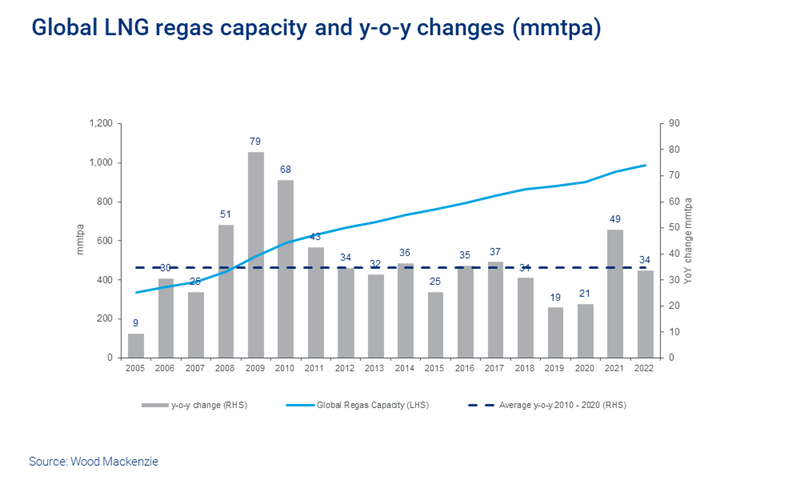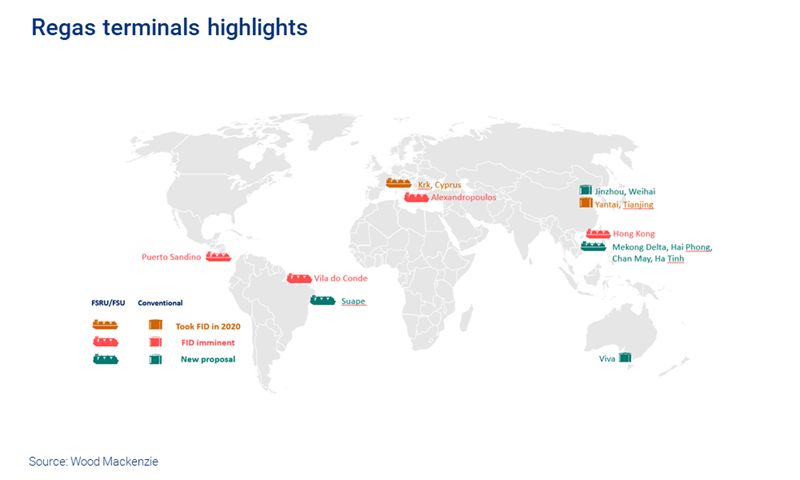Discuss your challenges with our solutions experts
LNG regasification: why there’s still plenty of gas in the tank
Global LNG regas project tracker Q3 2020
1 minute read
Giles Farrer
Vice President Research, Commodities, Gas & LNG

Giles Farrer
Vice President Research, Commodities, Gas & LNG
Giles heads our LNG and gas asset research and manages our market-leading LNG Service & Tool and LNG Corporate Service.
Latest articles by Giles
-
Opinion
Debating the future direction of the LNG market
-
The Edge
Positioning for global LNG’s next big growth phase
-
Opinion
Third wave US LNG: a $100 billion opportunity
-
Opinion
LNG: seismic shifts as Russia/Ukraine conflict makes waves
-
Opinion
LNG regasification: why there’s still plenty of gas in the tank
-
Opinion
How coronavirus is driving down LNG demand in Asia and Europe – and hitting supply
The regasification sector is in a strong position despite the short-term hit from Covid-19. Investment in further capacity is increasing, driven by the likelihood of robust long-term LNG demand growth.
Wood Mackenzie’s Global LNG Regas Project Tracker Q3 2020 provides a detailed picture of the regasification (regas) developments worldwide, including where capacity is growing, and which projects are most likely to be approved. Read a summary of the report’s main themes below.
Subscribe to Wood Mackenzie's LNG Service & Tool to get access to regular research like this, part of a package of data and insights providing a global perspective on the LNG market and founded on a deep understanding of key projects and economics around the world.
The coast is clear for new regas capacity
Even in the current environment, global regas is expanding. The amount of new capacity under construction this year – 144 million metric tonnes per annum (mmtpa) – is equivalent to 40% of the 2020 global LNG supply. Two-thirds of this capacity will come from 33 new LNG terminals, 10 of them based in China (which is the fastest-growing LNG demand centre), while the remaining are expansions of existing terminals.
This is not to say coronavirus has not had an impact. Many completion dates have been set back because of the pandemic. In China, for example, the completion dates for expanding two facilities due this year (Caofeidian and Rudong terminals) have slipped to 2021. The pandemic has also hit construction of pipeline infrastructure in South Asia, reducing available capacity at recently commissioned terminals.
Power shortages spur on projects in Southeast Asia
One of the most interesting areas to watch this year in the regas sector was Southeast Asia. Developers of terminals in Vietnam and Myanmar have completed their terminals in record time, as they raced to stave off the looming power shortages predicted in both countries.
A small-scale terminal in Thanlyin, near Myanmar’s capital Yangon, received its first LNG cargo from Petronas in May, while Hai Linh Company expects its Vũng Tàu development in Southeast Vietnam to begin commercial operations in the second quarter of next year.
Both developers have taken on added risk to get these regas projects over the line. In each case, work started on the privately-owned terminals before signing sales and purchases agreements with the end-users.
Elsewhere in the region, while Indonesia and the Philippines are adding further capacity, we are surprised by the lack of new developments in Malaysia, where we forecast LNG demand will outstrip regas capacity in just five years.
China’s national oil companies losing their dominance over regas terminals
China leads the way in terms of creating additional regas capacity, but access to this capacity is being turned on its head. The new national pipeline company, PipeChina, is intended to provide neutral access to pipeline infrastructure, encouraging investment in the sector by letting in small and non-state-owned companies. PipeChina is buying up the majority of PetroChina and Sinopec Corp’s domestic pipeline assets and is now likely to take ownership of several regas terminals from the national oil companies.
The move is set to shake up gas market liberalisation in China and kick-start a new midstream investment cycle, which is critical for China as it promotes gas as part of its energy mix.
For more information on China’s regas expansion projects and new terminals read the full report.
Not just an Asia story
Although the bulk of regas activity is happening within Asia, demand is also driving further investment across all regions.
One of the most notable proposed new regas terminals is in Mozambique, at the southern port of Matola. Although the country’s natural gas demand is modest, the Total and Giga Joule Group joint venture would service not just Mozambique’s Maputo/Matola region, but northern South Africa as well. The project will also replace gas from the declining Pande and Temane fields, which supply more than 30 industries across the region. Construction work could begin in the first quarter next year.
We are also watching Latin America closely, particularly Brazil. In February, the country achieved a milestone, with the country’s first import from a private LNG developer. Golar Power is bringing in supply via the Sergipe floating storage regasification unit (FSRU) in the north of the country. There have also been developments at Brazil’s second privately-owned LNG-to-power terminal, Porto Açu, in Rio de Janeiro. Expansion plans have been announced and Spic SPIC Brasil, a subsidiary of Chinese electricity company State Power Investment Corporation, has acquired a 33% stake in the terminal.
The next generation of regas capacity
Following on from the projects which have already taken final investment decisions (FID), more developments are waiting in the wings for approval to move to the construction phase. Three new regas terminals have received FIDs this year, one in Europe and two in China. We believe there are four more terminals which have a good chance of reaching FID before the end of 2020, one in Greece, another in Hong Kong and two further South American developments, in Brazil and Nicaragua. New terminals are also proposed for China, Australia, Vietnam, and Ecuador.
You may also be interested in Wood Mackenzie's Global Gas Model Next Generation, which allows you to build your own view of global gas markets. Learn more here.
Which projects will be next?
With 166 proposed LNG regas terminals at the pre-FID stage, Wood Mackenzie’s LNG project regas tracker evaluates each one, ranking it against the six key criteria which must be reached before an FID is taken: participation; end-user market; development concept and engineering; environmental and regulatory approvals; financing; and LNG supply.
To find out more, buy the report:








